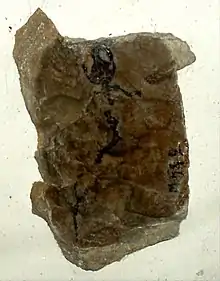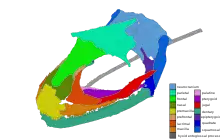Albanerpetontidae
The Albanerpetontidae are an extinct family of lissamphibians, distinct from other groups of modern amphibians. Albanerpetontids include six named genera – Albanerpeton, Anoualerpeton, Celtedens, Shirerpeton, Yaksha and Wesserpeton – and between 10 and 20 known species, spanning about 160 million years from the Bathonian stage of the Middle Jurassic to the beginning of the Pleistocene, about 2.13-2 million years ago.
| Albanerpetontidae | |
|---|---|
 | |
| Fossil of Celtedens ibericus, showing the remains of scales surrounding the body in grey | |
 | |
| Skull of Yaksha peretti | |
| Scientific classification | |
| Kingdom: | Animalia |
| Phylum: | Chordata |
| Class: | Amphibia |
| Subclass: | Lissamphibia |
| Order: | †Allocaudata Fox and Naylor, 1982 |
| Family: | †Albanerpetontidae Fox and Naylor, 1982 |
| Genera | |
History of Research

The earliest specimen of an albanerpetontid to be discovered was that of Celtedens megacephalus from the Early Cretaceous (Albian) Pietraroja Plattenkalk of Italy, described by Oronzio Gabriele Costa in 1864, and originally placed in the genus Triton, a junior synonym of the salamander genus Triturus.[1] Jaw elements of albanerpetontids from the Cretaceous of North America were assigned to the salamander genus Prosiren by Richard Estes in 1969, which was based on a vertebra.[2] Albanerpeton, the type genus of the family was first named by Estes and Hoffstetter in 1976 for the species of A. inexpectatum described from a large number of jaws and frontal bones described from a Miocene aged fissure fill deposit near Saint-Alban-de-Roche in France, and was initially classified as a salamander, and placed in the family Prosirenidae alongside Prosiren due to the morphological similarity with the previously described jaw fragments.[3] Fox and Naylor in 1982 realised that Albanerpeton was not a salamander, noting that the holotype vertebra of Prosiren was different to those of albanerpetontids, concluding that Albanerpeton was "well isolated from salamanders" and that it "seems no nearer phyletically to any other known amphibians, from Devonian to Recent" erecting the family Albanerpetontidae and the order Allocaudata to accommodate it.[4]
Description

Albanerpetontids were small (several centimetres in length) and superficially lizard-like. The skin of albanerpetontids was embedded with bony, fish like scales. The morphology of the complete 3 dimensionally preserved skull of Yaksha peretti suggests that Albanerpetontids had ballistic tongues akin to those of chameleons and plethodontid salamanders, as evidenced by the presence of a elongated rod shaped bone in the jaw cavity, dubbed the hyoid entoglossal process, which in life was embedded within the tongue. Analogous bones exists in chameleons and plethodontids, which allow rapid propulsion of the tongue.[5][6] Apomorphic characters for albanerpetontids include a complex mortise and tenon like joint connecting the dentary bones, non-pedicellate, slightly tricuspid, teeth, sculptured frontal bones, and an amniote-like ‘atlas-axis’ formed of three anterior cervical components.[7]
Life habits

The morphology of albanerpetontids suggests that they were sit-and-wait terrestrial predators and fed on invertebrates, similar to living plethodontids. The fact that the skull of the juvenile paratype of Yaksha was around 1/4 of the size of the adult suggests that albanerpetontids grew by direct development and did not have a metamorphic larval stage.[5]
Distribution
The distribution of Albanerpetontids is largely confined to Eurasia and North America, with remains also known from Morocco.[8][9] The first albanerpetontids are known from the western Palearctic (Europe and North Africa) in the Middle Jurassic (Bathonian), with the first known remains from North America occurring in the latter half of the Early Cretaceous. The last known remains of albanerpetontids in North America are from the Paskapoo Formation in Canada, dating to the Paleocene. All other Cenozoic members of the family, belonging to the genus Albanerpeton, are known from Europe, until their final appearance in Italy during the Early Pleistocene.[9]
Classification
Albanerpetontids were long thought to be salamanders because of their small size and generalized body plans.[10] However, these features are now thought to be ancestral for lissamphibians and not indicative of close relationships between the two groups.[11] Albanerpetontids are now recognized as a distinct clade of lissamphibians separate from the three living orders of amphibians – Anura (frogs), Caudata (salamanders), and Gymnophiona (caecilians). Most studies show them as more closely related to frogs and salamanders than to caecilians,[12] but bootstrap and Bayesian analyses show that this result is not robust and that they could also be sister-group of the Lissamphibia.[13] The presence of epipterygoids and a separate supraoccipital at least argues against a position within Batrachia.[7] A phylogenetic analysis in 2020 among lissamphibian relationships using multiple methods found no consensus for the position of Albanerpetontidae in relation to other lissamphibians.[5]
Taxonomy
- Genus Shirerpeton Matsumoto & Evans, 2018[7]
- Shirerpeton isajii Matsumoto & Evans, 2018 Early Cretaceous, Japan
- Genus Wesserpeton Sweetman & Gardner 2013
- Wesserpeton evansae Sweetman & Gardner 2013 Early Cretaceous, United Kingdom
- Genus Anoualerpeton Gardner, Evans & Sigogneau-Russell 2003
- Anoualerpeton priscus Gardner, Evans & Sigogneau-Russell 2003 Middle Jurassic, United Kingdom
- Anoualerpeton unicus Gardner, Evans & Sigogneau-Russell 2003 Late Jurassic, Morocco
- Genus Celtedens McGowan & Evans 1995 Late Jurassic-Early Cretaceous, Europe
- Celtedens megacephalus (Costa 1864) Early Cretaceous, Italy, United Kingdom
- Celtedens ibericus McGowan & Evans 1995 Early Cretaceous, Spain
- Genus Albanerpeton Estes & Hoffstetter 1976
- Albanerpeton arthridion Fox & Naylor 1982 Early Cretaceous, United States
- Clade "Gracile-snouted"
- Albanerpeton gracilis Gardner 2000 Late Cretaceous, North America
- Albanerpeton cifellii Gardner 1999 Late Cretaceous, United States
- Albanerpeton galaktion Fox & Naylor 1982 Late Cretaceous, North America
- Clade "Robust-snouted"
- Albanerpeton nexuosus Estes 1981 Late Cretaceous, North America
- Albanerpeton pannonicus Venczel & Gardner 2005 Pliocene-Early Pleistocene Hungary, Italy
- Albanerpeton inexpectatum Estes & Hoffstetter 1976 Oligocene-Miocene, Europe
- Genus Yaksha Daza et al, 2020
- Yaksha perettii Daza et al, 2020 Late Cretaceous, Myanmar
- Fragmentary remains of albanerpetontids are also known from the Bathonian aged Anoual Formation of Morocco,[14] The Bathonian aged Aveyron locality of France,[7][15] the Tithonian aged Chassiron locality of France,[16] the Cenomanian-Turonian Khodzhakul and Bissekty Formations of Uzbekistan, originally assigned to the dubious genus Nukusaurus[17] and the Santonian aged Csehbánya Formation of Hungary.[18]
References
- O. G. Costa. 1864. Paleontologia del Regno di Napoli. Parte III [Paleontology of the Kingdom of Naples. Part III]. Atti dell'Accademia Pontaniana 8:1-192
- Estes, R. (October 1969). "Prosirenidae, a New Family of Fossil Salamanders". Nature. 224 (5214): 87–88. doi:10.1038/224087a0. ISSN 0028-0836.
- R. Estes and R. Hoffstetter. 1976. Les urodèles du Miocène de La Grive-Saint-Alban (Isère, France) [The urodeles from the Miocene of La Grive-Saint-Alban (Isère, France)]. Bulletin du Muséum National d’Histoire Naturelle, Sciences de la Terre 57:297-343
- Fox, Richard C.; Naylor, Bruce G. (1982-01-01). "A reconsideration of the relationships of the fossil amphibian Albanerpeton". Canadian Journal of Earth Sciences. 19 (1): 118–128. doi:10.1139/e82-009. ISSN 0008-4077.
- Daza, Juan D.; Stanley, Edward L.; Bolet, Arnau; Bauer, Aaron M.; Arias, J. Salvador; Čerňanský, Andrej; Bevitt, Joseph J.; Wagner, Philipp; Evans, Susan E. (2020-11-06). "Enigmatic amphibians in mid-Cretaceous amber were chameleon-like ballistic feeders". Science. 370 (6517): 687–691. doi:10.1126/science.abb6005. ISSN 0036-8075.
- Yarlagadda, Tara (5 November 2020). "Scientists Think They've Finally Solved a 99 million-Year-Old Fossil mystery - Meet the albie — a highly unusual amphibian with a wild, slingshot tongue". Inverse. Retrieved 6 November 2020.
- Matsumoto, Ryoko; Evans, Susan E. (2018). "The first record of albanerpetontid amphibians (Amphibia: Albanerpetontidae) from East Asia". PLOS ONE. 13 (1): e0189767. doi:10.1371/journal.pone.0189767. PMC 5752013. PMID 29298317.
- Gardner, J.D.; Böhme, M. (2008). Sankey, J.T.; Baszio, S. (eds.). Vertebrate Microfossil Assemblages: Their Role in Paleoecology and Paleobiogeography (PDF). Indianapolis: Indiana University Press. pp. 178–218. Retrieved 9 January 2012.
- Villa, Andrea; Blain, Hugues-Alexandre; Delfino, Massimo (2018). "The Early Pleistocene herpetofauna of Rivoli Veronese (Northern Italy) as evidence for humid and forested glacial phases in the Gelasian of Southern Alps". Palaeogeography, Palaeoclimatology, Palaeoecology. 490: 393–403. doi:10.1016/j.palaeo.2017.11.016. ISSN 0031-0182.
- Duellman, W.E. & Trueb, L. (1994): Biology of amphibians. The Johns Hopkins University Press
- Wesserpeton evansae: making 'albanerpetontid' a household name
- Gardner, J. D. (2001). "Monophyly and affinities of albanerpetontid amphibians (Temnospondyli; Lissamphibia)". Zoological Journal of the Linnean Society. 131 (3): 309–352. doi:10.1111/j.1096-3642.2001.tb02240.x.
- Marjanović, David; Laurin, Michel (2019). "Phylogeny of Paleozoic limbed vertebrates reassessed through revision and expansion of the largest published relevant data matrix". PeerJ. 6 (e5565): 1–191. doi:10.7717/peerj.5565.
- Haddoumi, Hamid; Allain, Ronan; Meslouh, Said; Metais, Grégoire; Monbaron, Michel; Pons, Denise; Rage, Jean-Claude; Vullo, Romain; Zouhri, Samir (January 2016). "Guelb el Ahmar (Bathonian, Anoual Syncline, eastern Morocco): First continental flora and fauna including mammals from the Middle Jurassic of Africa" (PDF). Gondwana Research. 29 (1): 290–319. doi:10.1016/j.gr.2014.12.004. ISSN 1342-937X.
- Seiffert J. Urodelan atlas aus dem obersten Bajocien von S.E. Aveyron (Südfrankreich). Palaontol Z. 1969;43:32–6.
- Vullo, Romain; Abit, Dominique; Ballèvre, Michel; Billon-Bruyat, Jean-Paul; Bourgeais, Renaud; Buffetaut, Éric; Daviero-Gomez, Véronique; Garcia, Géraldine; Gomez, Bernard; Mazin, Jean-Michel; Morel, Séverin (July 2014). "Palaeontology of the Purbeck-type (Tithonian, Late Jurassic) bonebeds of Chassiron (Oléron Island, western France)". Comptes Rendus Palevol. 13 (5): 421–441. doi:10.1016/j.crpv.2014.03.003.
- Skutschas, Pavel P. (2013). "Mesozoic salamanders and albanerpetontids of Middle Asia, Kazakhstan, and Siberia" (PDF). Palaeobiodiversity and Palaeoenvironments. 93 (4): 441–457. doi:10.1007/s12549-013-0126-8.
- Szentesi, Zoltán; Gardner, James D.; Venczel, Márton (March 2013). Sues, Hans (ed.). "Albanerpetontid amphibians from the Late Cretaceous (Santonian) of Iharkút, Hungary, with remarks on regional differences in Late Cretaceous Laurasian amphibian assemblages". Canadian Journal of Earth Sciences. 50 (3): 268–281. doi:10.1139/e2012-024. ISSN 0008-4077.